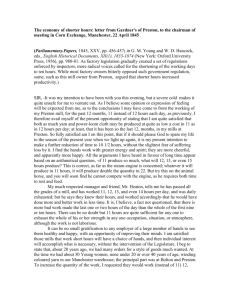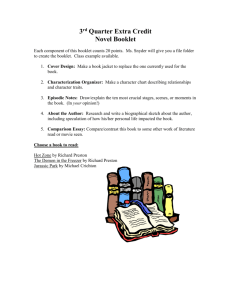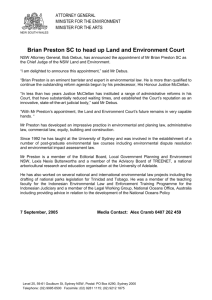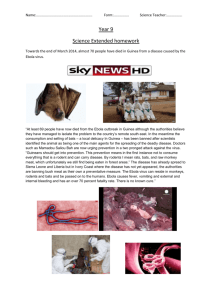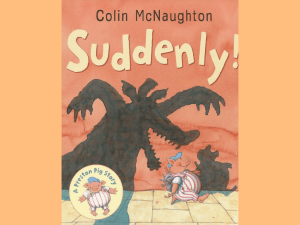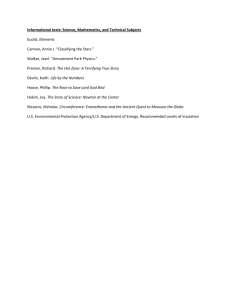STUDY GUIDE QUESTIONS for “The Hot Zone”
advertisement
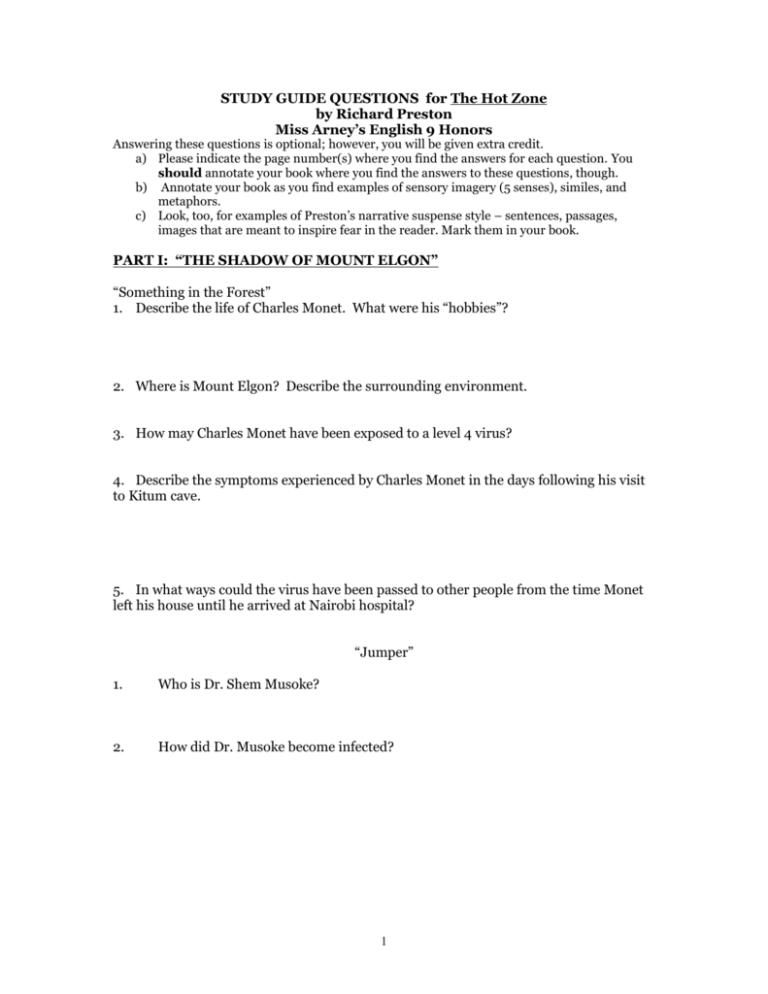
STUDY GUIDE QUESTIONS for The Hot Zone by Richard Preston Miss Arney’s English 9 Honors Answering these questions is optional; however, you will be given extra credit. a) Please indicate the page number(s) where you find the answers for each question. You should annotate your book where you find the answers to these questions, though. b) Annotate your book as you find examples of sensory imagery (5 senses), similes, and metaphors. c) Look, too, for examples of Preston’s narrative suspense style – sentences, passages, images that are meant to inspire fear in the reader. Mark them in your book. PART I: “THE SHADOW OF MOUNT ELGON” “Something in the Forest” 1. Describe the life of Charles Monet. What were his “hobbies”? 2. Where is Mount Elgon? Describe the surrounding environment. 3. How may Charles Monet have been exposed to a level 4 virus? 4. Describe the symptoms experienced by Charles Monet in the days following his visit to Kitum cave. 5. In what ways could the virus have been passed to other people from the time Monet left his house until he arrived at Nairobi hospital? “Jumper” 1. Who is Dr. Shem Musoke? 2. How did Dr. Musoke become infected? 1 3. What did Dr. Musoke do that contributed to the spread of the disease? What would you have done differently? 4. Describe the results of Dr. Musoke’s exploratory surgery. 5. While this chapter is slightly less….vivid than the last, what does Preston do to increase the reader’s fear, horror, or anxiety? Is it effective? Did it work with you? Explain. 6. Explain the significance of this chapter title. Diagnosis 1. Who is David Silverstein? 2. What virus was found in Dr. Musoke’s blood? Describe the virus and it’s origin. 3. What is a filovirus? 4. Which is the worst of the filovirus “sisters”? What is the kill rate in humans? 5. Describe the information provided by “Mr. Jones” concerning the Marburg virus. 6. What is one general theory for the origin of AIDS? 7. What was the outcome for Dr. Musoke? 2 8. What is the shape of Marburg virus? 9. The author lists four possible intermediate hosts (39). Make a case for or against any two of them. 10. Why does the author reason that a monkey or human cannot be the primary host for the virus? 11. Mr. Jones feels guilty about the outcome. Should he accept blame for what happened? Why or why not? 12. What was being done with the sick monkeys? Why was this dangerous? 13. What is the science of epidemiology? Analyze the prefix/root/suffix structure of this word. 14. Why does the author compare Charles Monet to “an Exocet missile struck below the water line”? Explain the metaphor. A Woman and A Soldier 1. Who is Nancy Jaax? 2. How did Nancy Jaax cut her hand? Why is this significant? 3. Nancy and Jerry “had grown up on farms in Kansas, twenty miles apart as the crow flies…” What does this expression mean? 4. What examples of foreshadowing does Preston use in this chapter? 5. How does Preston build tension and suspense in this chapter? 3 “Project Ebola” 1. What does USAMRIID stand for? 2. Describe the brief history of Biological Weapons in the U.S. 3. What kinds of precautions were necessary for Nancy Jaax to be able to work in Biosafety Level 3 conditions? What problems did she face? 4. What is unique about Biosafety Level 4? 5. How did Nancy Jaax end up working in Biosafety Level 4? 6. Describe the first known emergence of the Ebola virus. How did it get its name? 7. Who is Eugene Johnson? 8. How many different proteins make up an Ebola virus particle? What is known about them? 9. Describe the effects of the Ebola virus. How does it appear to be spread? 10. Describe the Biosafety Level staging area. Describe the suit required for work in Biosafety Level 4. 11. Compare HIV to Ebola in terms of their transmission? 12. What is the relevance of the practice of cleaning up dead bodies for burial? 13. Find two passages that you feel are written to evoke the most fear or anxiety in the reader. Explain why and how. 4 14. Find one example of a simile and one of a metaphor in this chapter. Explain the use of these devices. 15. Preston writes, “Perhaps Nancy was in a bit of a hurry and did not inspect her space suit as closely as she should have.” Why does Preston include this speculation? 16 17. Why does Preston break the page at the end of the chapter to put in the graphic of the biohazard warning signs? What are some people’s superstitions in dealing with level 4? “Total Immersion” 1. Describe the symptoms exhibited by the monkeys that were infected with Ebola. 2. What internal conflict does Nancy Jaax experience when she faces the monkeys? Explain. 3. Preston describes Johnson and Jaax carrying the dead monkey: “They were two human primates carrying another primate. One was the master of the earth, or at least believed himself to be, and the other was a nimble dweller in trees, a cousin of the master of the earth. Both species, the human and the monkey, were in the presence of another life form, which was older and more powerful than either of them, and was a dweller in blood” (57). Explain the significance and impact of this passage. Why does he juxtapose the second sentence after the first? 4. Describe the structure of a typical virus. 5. What “scare” did Nancy Jaax have while working with Ebola? 5 6. What happened to the Ebola infected monkeys? What became of the healthy monkeys? How? 7. What is the Slammer? The Submarine? Why would these places be given such nicknames in your opinion? 8. Find as many examples of similes and metaphors in this chapter as you can; annotate them in your book and write down at least one here. 9. Preston uses a mythological allusion to describe the virus? What is the allusion? Explain the reference to mythology and why Preston would use it for the virus. 10. Find an example of repetition in this chapter. Why do you think Preston uses it? 11. Did you expect Jaax to have contracted the virus? Why or why not? Do you think Preston intended for the reader to become anxious that she had? Defend your position. 12. What cliffhanger does Preston end the chapter on? Why is this a cliffhanger? “Ebola River” 1. Who is Mr. Yu G.? 2. Describe Ebola Sudan. 3. Describe Ebola Zaire. 4. Describe how the disease was spread through the Yambuku hospital. 6 5. Describe the shape of the Ebola virus. 6. What is the C.D.C.? 7. Who is Nurse Mayinga? Describe her situation. 8. Describe how the medical teams worked to prevent the further spread of the disease throughout Kinshasa. 9. How many other people caught the virus from Nurse Mayinga? 10. Review the paragraph beginning, “There was another possible reason why the Ebola Suden virus vanished” and ending with “The Ebola virus, in its Sudan incarnation, retreated to the heart of the bush, where undoubtedly it lives to this day, cycling and cycling in some unknown host, able to shift its shape, able to mutate and become a new thing, with the potential to enter the human species in a new form.” In this passage, Preston adopts an ominous tone. Explain the threat posed, how the author uses it to create suspense, and how this is meant to be an example of foreshadowing. 11. Preston has another shift in narration to first person: “I can see her in my mind’s eye – Nurse Mayinga, the source of the virus in the United States Army’s freezers.” Why do you think he shifts in this paragraph (you will need to read the remainder of the chapter to understand)? 12. What are the implications if the virus is airborne? 13. Keep tracking your similes and metaphors! 7 “Cardinal” 1. Who is Eugene Johnson? 2. Who is Peter Cardinal? 3. Explain why a virus may be more like a predator than a parasite. 4. How might Peter Cardinal have become infected? 5. Why does Preston end the chapter with a series of questions? “Going Deep” 1. Describe the expedition to Kitum Cave. What was the purpose of this trip? 2. What was the result of this expedition? 3. Visit my website for the link to the page about Africa’s animals to see pictures of those mentioned in this chapter. 4. What is a sentinel animal? Did you have any reaction reading this passage? 5. Why does he end this chapter (and this section) with the sentence and image he does? PART II: “THE MONKEY HOUSE” “Reston” 1. What kinds of monkeys were kept at the Reston Monkey House? 2. How many monkeys out of the original shipment did Bill Volt count as dead within one month’s time? 3. Who is Dan Delgard? 8 4. Describe the deaths of the monkeys. 5. Describe the social structure (hierarchy) of the monkeys. How do you think this should affect the way their human handlers store and treat them? “Into Level 3” 1. Who is Peter Jahrling? 2. What is Jahrling’s reason for electing not to work with Ebola and Marburg? How does this declaration reflect the dramatic subject matter in this book? Notice where and how Preston chooses to include that statement (pay attention to the layout of the page too). 3. How did Delgard ship the results of the monkey autopsy to Jahrling? 4. What is ironic about Jahrling’s comment about how Dalgard shipped the sample? 5. “A freezer can be hot as hell.” What literary device is used here? What does the author mean in this case? Why would he phrase it this way? 6. Review the final two paragraphs, paying special note to how Preston ends this chapter. Why does he end this chapter with this image? 7. Are you annotating your similes, metaphors, and sensory images? 9 “Exposure” 1. Who is Tom Geisbert? 2. Preston uses an extended metaphor to describe cells. This is a metaphor that goes on for several sentences. Find this extended metaphor. What comparison does Preston make? Why would he choose to use this device/ use this comparison here? 3. What does the expression “off the plastic” mean? 4. Why do you think Preston makes a big deal of Jahrling and Geisbert sniffing the culture? How might this be an example of foreshadowing? What earlier ominous statements has Preston made to set this moment up? Was it a mistake for them to do this? 5. Look at the final passage of this chapter starting with “Geisbert poured some of the milky fluid out of the flask….” and ending with “Then comes the headache.” Notice the abrupt shift from Geisbert preparing for his hunting trip to the next sentence: “When a filovirus begins to amply itself in a human being….” What implication is Preston making with the juxtaposition of these two sentences? What mood does this create? He certainly likes these “cliffhangers”, doesn’t he? “Thanksgiving” 1. What significant event occurred over the Thanksgiving holiday in the monkey house? 2. What are the possible reasons to explain how the virus had apparently jumped from room F to room H? Try to brainstorm at least 2 hypotheses. 10 “Medusa” 1. What discovery did Geisbert make about the viruses infecting the monkeys? 2. Notice the list of questions Geisbert asks himself upon determining he was looking at Marburg. What tone is being conveyed here? Why? Is it appropriate given the situation? 3. Another mythological allusion (which you probably noticed from the title of the chapter). Explain the mythological reference and its application to the text. Did Preston make a good use of the allusion / is it fitting? Why/not? (Didn’t I warn you that mythology is everywhere?) 4. Notice the use of personification in the final paragraph. What is it and what image does it convey? “The First Angel” 1. Who is C.J. Peters? 2. What was the purpose of the conversation between Jahrling and Geisbert? (see page 206.) 3. What came of this conversation? 4. Preston is fond of using narrative suspense (creating suspense through his narration). How does he use it in this chapter? 5. What example of foreshadowing can you find in this chapter? 11 “The Second Angel” 1. Describe Jahrling's tests with the virus samples. 2. What were the results of these tests? 3. Notice the build-up to the final paragraph. What mood does Preston create in the final paragraphs? How? “Chain of Command” 1. What is meant by a “chain of command” in relation to biohazard work? 2. Why does Jahrling repeat the test? 3. What are the three ways to eliminate a virus? Which are or are not applicable at this point? 4. How can biocontainment be achieved? “Garbage Bags” 1. Who is Jarvis Purdy? What happened to him? 2. How were the dead monkey’s shipped to Fort Detrick? 12 3. What are the dangers of the media getting hold of this information? Is there a benefit to the news media knowing what is happening at this point? Defend your position. 4. Another military term: nuke. What does it mean in this context? What does it normally mean/ refer to? Why would this term be used here for this type of biohazard procedure? Space Walk 1. What were the results of the monkey autopsy? 2. Why is Nancy Jaax disappointed? Shoot-Out 1. Who is Joe McCormick? 2. Review the passage in the hut in the Zande village. After jabbing himself with the bloody needle, he chooses to stay and help others. Was he brave and selfless….or stupid and reckless? Defend your position. 3. How does this experience shape his perspective on the danger of Ebola? 4. What image does the implied metaphor of the final sentence create to you? “The Mission” 1. What are the Three Priorities? 2. Why is Kitum Cave so important to the story? How was the monkey house like Kitum Cave? 13 “Reconnaissance” 1. Describe the conditions of the monkey house upon the team entering the building. 2. And yet another example of narrative suspense as Preston describes the Army sealing up the building….and not knowing about the back rooms. Find that passage. PART III: “SMASHDOWN” *What does the title of this section imply? Insertion 1. Describe the orange Racal suits that are designed for use with airborne biological agents. 2. Describe the decontamination process upon leaving the monkey building. 3. As if things couldn’t get worse, we learn something about the setting of the monkey house…what is it? (and this would be the type of detail that seems contrived in movies! Real life is truly stranger than fiction!). 4. And yet another mythological allusion (paragraph 2 of this chapter). What is it? Explain the reference and connection to the text. 5. Consider for class discussions the example of anti-feminism regarding Nancy Jaax. Do you think that this work should not be taken on by females? Married females? Are married men less likely to “neglect [their] work or neglect [their]” familes? 14 6. Based on the information the media has, is the article sensationalizing the situation? Defend your response. *Consider for class discussion: Does the public have a right to know or did the article provide enough information? 7. Notice the paradox in these images: “By late afternoon, all the monkeys in Room H had been put to death. Behind the building, through the trees and down the hill, children ran in circles around their playhouse.” What two images/ ideas are being juxtaposed here by the author? 8. Quite a way to end a chapter! Why does Preston do this? “A Man Down 1. Who is Milton Frantig? What happened to him? 2. What is the meaning of the title of this chapter? Did you expect a different outcome from the chapter based on this title? 3. Note the use of onomatopoeia at the end of the chapter. What mood does it create? “91-Tangos” 1. How many monkeys occupied the building? 2. Explain the paradox of this image: “They [the military] became trapped in rushhour traffic again, surrounded by half-asleep yuppies in suits who were sucking coffee from foam cups and listening to traffic reports and easy rock and roll.” 3. How does Preston end this chapter? What mood does it evoke? 15 “Inside” 1. What happened to Rhonda Williams? 2. Keep track of those literary devices! “A Bad Day” 1. What do you think Preston hopes to do by giving the chapter this title? 2. What significant event occurred on Wednesday December 6? 3. What did the team do to the remaining monkey’s that were still alive? 4. Look at the last passage beginning with the paragraph, “Specialist Rhonda Williams was standing….” and ending with the conclusion of the chapter. Do you think this really happened? Defend your position. Consider this: Do you think Preston wanted a movie to be made about his book? How would this scene work in a movie? “Decon” 1. Describe how the team attempted to “Decon” the monkey house. 2. How did they know if they were successful or not? “The Most Dangerous Strain” 1. Describe the Ebola Reston virus strain. 2. How many humans died from Ebola Reston? 3. Why is the Reston virus so much like Ebola Zaire, when Reston supposedly comes from Asia? 16 4. The crisis was averted…but Preston is not done with his narrative suspense. Find some examples of his cliffhanger/ominous writing style in this chapter to keep the reader worried about a potential outbreak somewhere. 5. Do you think the final line is a good way to end this main part of the book? Why or why not? PART IV: “KITUM CAVE” 1. Describe the author’s journey to Kitum Cave. Why did he make this journey? 2. How did AIDS likely first appear? 3. Why have vaccines against HIV been unsuccessful? 4. What became of the Reston, Virginia monkey house? 5. Find yet a final mythological allusion (in “Camp”) and explain the reference. 17 6. What is the author's view on the emergence of these destructive viruses? 7. Might this book be a cautionary tale (like the myths of hubris or the warning in Jurassic Park) about man and nature? Can you think of a lesson we are supposed to learn? When we re-examine the text together, you may be given deeper questions to analyze and some of these questions will be discussed and debated in class. Remember: writing out answers to these questions is optional. What questions do you have as you finish this book? Jot them below and bring them up in class or on the blog (from my website): Any important questions that you would have asked in this study guide that I missed? If you were the teacher of the class, what possible essay questions would you assign? (Try to get in my head! It is a scary place in there, though, so be careful!) 18
